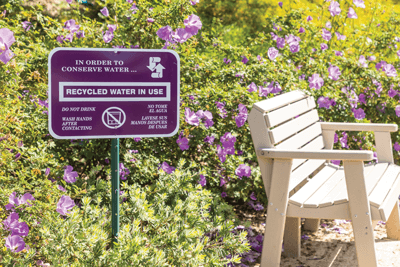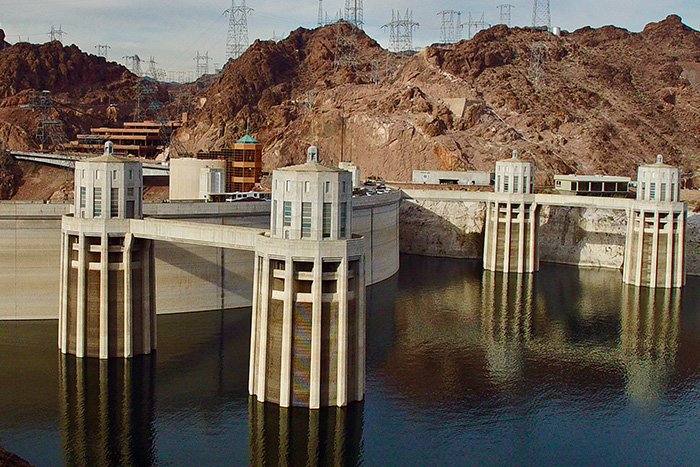For a green industry entrepreneur, the excitement of starting or owning a business is connected to thoughts of using your passion to tap into a fertile market. It’s dreaming about new services to offer and researching the best ways to market and sell to new customers. And of course, you can’t forget the importance of finding the best equipment to do the job right.
Somehow regulations and compliance don’t tend to top the list. But they are just as important.
When it comes to successfully running a landscape or irrigation company, the first order of business is making sure your business is in compliance with applicable regulations and requirements. But developing and implementing a comprehensive safety plan that also adheres to proper chemical and water use requirements requires navigating multiple federal and state agencies, along with a lot of research, advance planning and documentation.
Staying safe
As an employer, the Occupation Safety and Health Administration mandates that it is your duty to assess each work site for any and all hazards in order to protect employees from harm, whether you employ one person or 500.
In a plant, factory or other work site contained within four walls, the hazards are fairly predictable from day to day. However, when work sites vary, as is common in landscape and irrigation, the hazards are ever-changing, says Jeffrey Lancaster, founder and CEO of Lancaster Safety Consulting based in Wexford, Pennsylvania.

“When you go out to different sites, the hazards change based on the site,” Lancaster says. “It can be heat, it can be weather. If it is the first time out to a particular job site, the employer has the requirement to assess the job site for hazards, develop a safe working plan, and train your employees on that plan.”
While OSHA standards and regulations are similar across all states, employers in some states are subject to slight variances or modifications. Lancaster says that’s because about half of OSHA offices are federally run while the other half are governed by an office on the state level. OSHA also offers QuickTakes, a free newsletter that is distributed twice monthly and includes information on compliance assistance, outreach activities, training and educational resources, and the most updated information about enforcement actions.
Lancaster suggests that every employer assign an employee to stay on top of current requirements. A safety consultant who is well-versed on OSHA standards for a specific business can also serve as an invaluable resource. That consultant can quickly go down the list of standards and determine those that should be included in that company’s safety plan.
“It can save a ton of time and second-guessing,” Lancaster says. “The employer has to have a written safety program, and while there are some exceptions for small employers, it is common sense and easier on the employer to have a written program in place. OSHA can conduct an inspection at any time, and if a safety plan isn’t available, you can be cited. OSHA 101 is to find out what regulations pertain to your operation, develop custom written safety plans for those regulations, train workers on those regulations and document the training.”
If employees are using pesticides or fertilizers in the field, the protocol falls under OSHA’s hazard communication standard, and an employer needs to provide a Safety Data Sheet for each chemical and provide training on the safe handling of those chemicals.
OSHA also requires landscape and irrigation companies to provide personal protective equipment to each employee, which requires the employer to assess each workplace and determine what PPE is needed for the tasks at hand. Then it is the employer’s responsibility to provide training on proper use of the PPE and all other safety standards.
According to Lancaster, OSHA has a broad acceptance of how training takes place. That means it can take the form of a casual training session wherever and whenever it works best. It can take place on the job site, where a new hire is closely supervised and encouraged to ask questions. Or, it can be held in an air-conditioned classroom with a PowerPoint presentation. Lancaster says that most of his clients offer an annual, thorough safety training or review. If the business operates seasonally, this annual refresher is especially important.
“A large percentage of injured workers are workers who haven’t been completely or properly trained,” Lancaster says. “Employers have to be disciplined and understand up front that when they bring someone new on, regardless of their experience, they have to receive site and employer-specific training. It is always a challenge because of the changing workforce, where people abruptly quit and you have to hire others.”
Language barriers are also a key issue in communicating a safety plan and in providing proper and complete training.
“You may have a sophisticated plan in English, but if you hire a non-English speaker, how do you acknowledge that an employee understands the program?” John Farner, government and public affairs director for the Irrigation Association, Fairfax, Virginia, says. “If there is more than one language, you must somehow properly communicate the safety expectations before he or she begins work.”
Once training is complete, employers need to document that training took place. That can be as simple as having a sign-in sheet. If an employee chooses not to follow their training and gets hurt on the job, Lancaster says an employer should have documentation that proper training did take place.
“Happy workers are more productive,” he says. “If employers can avoid accidents and injuries and workers compensation claims, that’s where their profitability comes from.”
Smart water and chemical use
In addition to complying with OSHA standards by providing a SDS for each chemical that employees will use, federal law requires that any person who applies or supervises the use of pesticides be trained in accordance with Environmental Protection Agency regulations and certified as a private or commercial applicator through each state or territory where they do business. As with OSHA standards, state requirements can vary from federal requirements.
In California, the use of pesticides is governed by the California Department of Pesticide Regulation, which has a comprehensive system for certifying and licensing landscapers who intend to use pesticides as part of their business.

According to DPR’s Craig Cassidy, there are different certification and licensing levels depending on the types of pesticides to be applied. DPR’s website offers a wealth of information detailing the process of obtaining the proper licensing.
“New regulations are continually updated on our website,” Cassidy says. “Licensees are also required to take continuing education courses and take exams to maintain their licensing and certification. Certificate holders/ licensees are also trained on understanding and following product labels, which are approved by the EPA and legally enforceable.”
DPR also requires reporting for some types of pesticide applications, and reporting guidelines and requirements are covered in licensee training.
While regulations for using pesticides are more widely applicable across regions, when it comes to water usage and regulations, there is variation by state, by region and by water district. Therefore, contractors working in many regions or water districts will want to become familiar with the regulations in each area.
“If you’re a landscape contractor and you cover a wide area, you could deal with 13 to 15 different water districts,” says Nate Adams, water reliability planning manager for the Santa Margarita Water District in Southern California. “After a rain event you have to suspend irrigation for 48 hours, across the board for California. But some districts limit the days of the week that you can water, and you have to know the differences if you want to stay ahead.”
In terms of water usage, staying ahead means knowing how often you can water in a particular area and how much water a particular landscape needs, and then setting up an irrigation system to meet those needs within the parameters of the water district’s regulations. While companies aren’t required to keep records of their water schedules, they are incentivized to install efficient systems with budget-based rate structures.
Adams says that becoming familiar with water regulations also allows contractors to educate their clients on local rebate programs.
“One role they can play is to make sure clients know about the different rebate programs their district has for efficient irrigation products so they can install efficient products and their client can receive monetary offsets,” he says.
Make your voice heard
While regulations and standards are set up across multiple agencies to protect the community at large, businesses and workers, sometimes those regulations can have unintended or unnecessary consequences on the industry.
In 2010, when Texas began to experience a drought more severe than they had seen in generations, early regulations cut off all irrigation to landscapes, greenhouses and nursery operations, effectively stopping business in its tracks.
“The response to the drought was going to decimate the industry,” says Farner. “The Texas landscape industry did a great job responding along with like-minded organizations to educate state officials and water providers on what this would do, and through this effort created the Texas Water Smart program.”
In order to have a voice in issues that impact your business, Farner says the first step is to understand which agency has oversight, then work with like-minded entities to educate those agencies about what you do and how it benefits the community.
“First, know who is regulating you,” Farner says. “Then work with other companies to make sure those oversight agencies understand the landscaping industry and the intricacies involved.”
Educating policymakers about the landscape industry can prove very effective on a wide variety of issues, especially drought planning and labor issues. Every jurisdiction should have a drought plan, and in different stages of drought, those policies could impact the installation of new plant material or the irrigation of existing material. This is where education can pay dividends.
“Make sure those governing bodies who develop the drought plans understand the importance and value of what landscapes bring to the table,” Farner says.
As you work to build on the success of your business, don’t discount the importance of putting a focus on compliance and regulation. Being aware of these issues and the agencies involved can not only benefit your employees and help you avoid non-compliance penalties, it also enables you to have your voice heard to help shape future policy development.
Make a change
 When it comes to lobbying for change, John Farner, government and public affairs director for the Irrigation Association, Fairfax, Virginia, says working with competitors to present a unified voice is a great way to educate policymakers.
When it comes to lobbying for change, John Farner, government and public affairs director for the Irrigation Association, Fairfax, Virginia, says working with competitors to present a unified voice is a great way to educate policymakers.
“It can be informal,” Farner says. “There is nothing wrong with working with competitors to sit down with city council or local water providers to educate them. You can do this on your own, through associations like the Irrigation Association at the national level, or through other trade organizations to elevate your trade through advocacy.”
While trade associations are working on your behalf, Farner encourages business owners to keep the lines of communication open and to reach out with specific pain points or feedback.
“Continue your relationships with trade associations and let them know what kind of challenges you are facing with regulations,” Farner says. “Don’t assume professional trade staff know everything. They don’t always know how one specific regulation affects every business out there. That will inform us how to become better advocates on behalf of the industry.”





